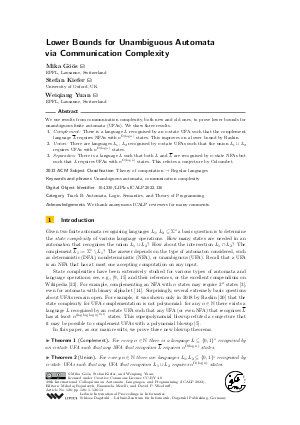Lower Bounds for Unambiguous Automata via Communication Complexity
Authors Mika Göös, Stefan Kiefer, Weiqiang Yuan
-
Part of:
Volume:
49th International Colloquium on Automata, Languages, and Programming (ICALP 2022)
Part of: Series: Leibniz International Proceedings in Informatics (LIPIcs)
Part of: Conference: International Colloquium on Automata, Languages, and Programming (ICALP) - License:
 Creative Commons Attribution 4.0 International license
Creative Commons Attribution 4.0 International license
- Publication Date: 2022-06-28
File

PDF
LIPIcs.ICALP.2022.126.pdf
- Filesize: 0.75 MB
- 13 pages
Document Identifiers
Subject Classification
ACM Subject Classification
- Theory of computation → Regular languages
Keywords
- Unambiguous automata
- communication complexity
Metrics
- Access Statistics
-
Total Accesses (updated on a weekly basis)
0Document
0Metadata
Abstract
We use results from communication complexity, both new and old ones, to prove lower bounds for unambiguous finite automata (UFAs). We show three results. 1) Complement: There is a language L recognised by an n-state UFA such that the complement language ̅L requires NFAs with n^Ω̃(log n) states. This improves on a lower bound by Raskin. 2) Union: There are languages L₁, L₂ recognised by n-state UFAs such that the union L₁∪L₂ requires UFAs with n^Ω̃(log n) states. 3) Separation: There is a language L such that both L and ̅L are recognised by n-state NFAs but such that L requires UFAs with n^Ω(log n) states. This refutes a conjecture by Colcombet.
Cite As Get BibTex
Mika Göös, Stefan Kiefer, and Weiqiang Yuan. Lower Bounds for Unambiguous Automata via Communication Complexity. In 49th International Colloquium on Automata, Languages, and Programming (ICALP 2022). Leibniz International Proceedings in Informatics (LIPIcs), Volume 229, pp. 126:1-126:13, Schloss Dagstuhl – Leibniz-Zentrum für Informatik (2022)
https://doi.org/10.4230/LIPIcs.ICALP.2022.126
BibTex
@InProceedings{goos_et_al:LIPIcs.ICALP.2022.126,
author = {G\"{o}\"{o}s, Mika and Kiefer, Stefan and Yuan, Weiqiang},
title = {{Lower Bounds for Unambiguous Automata via Communication Complexity}},
booktitle = {49th International Colloquium on Automata, Languages, and Programming (ICALP 2022)},
pages = {126:1--126:13},
series = {Leibniz International Proceedings in Informatics (LIPIcs)},
ISBN = {978-3-95977-235-8},
ISSN = {1868-8969},
year = {2022},
volume = {229},
editor = {Boja\'{n}czyk, Miko{\l}aj and Merelli, Emanuela and Woodruff, David P.},
publisher = {Schloss Dagstuhl -- Leibniz-Zentrum f{\"u}r Informatik},
address = {Dagstuhl, Germany},
URL = {https://drops.dagstuhl.de/entities/document/10.4230/LIPIcs.ICALP.2022.126},
URN = {urn:nbn:de:0030-drops-164679},
doi = {10.4230/LIPIcs.ICALP.2022.126},
annote = {Keywords: Unambiguous automata, communication complexity}
}
Author Details
Acknowledgements
We thank anonymous ICALP reviewers for many comments.
References
- Noga Alon. Problems and results in extremal combinatorics-I. Discrete Mathematics, 273(1-3):31-53, 2003. URL: https://doi.org/10.1016/S0012-365X(03)00227-9.
- Kaspars Balodis, Shalev Ben-David, Mika Göös, Siddhartha Jain, and Robin Kothari. Unambiguous DNFs and Alon-Saks-Seymour. In 62nd IEEE Annual Symposium on Foundations of Computer Science (FOCS), 2021. To appear. Available at URL: https://arxiv.org/abs/2102.08348.
- Jean-Camille Birget. Partial orders on words, minimal elements of regular languages, and state complexity. Theoretical Computer Science, 119(2):267-291, 1993. URL: https://doi.org/10.1016/0304-3975(93)90160-U.
- Mikołaj Bojańczyk and Wojciech Czerwiński. An automata toolbox, 2018. Available at URL: https://www.mimuw.edu.pl/~bojan/paper/automata-toolbox-book.
- Thomas Colcombet. Unambiguity in automata theory. In 17th International Workshop on Descriptional Complexity of Formal Systems (DCFS), volume 9118 of Lecture Notes in Computer Science, pages 3-18. Springer, 2015. URL: https://doi.org/10.1007/978-3-319-19225-3_1.
- Thomas Colcombet, Karin Quaas, and Michał Skrzypczak. Unambiguity in Automata Theory (Dagstuhl Seminar 21452). Dagstuhl Reports, 11(10):57-71, 2022. URL: https://doi.org/10.4230/DagRep.11.10.57.
- Wojciech Czerwiński, Laure Daviaud, Nathanaël Fijalkow, Marcin Jurdziński, Ranko Lazić, and Pawel Parys. Universal trees grow inside separating automata: Quasi-polynomial lower bounds for parity games. In Proceedings of the 2019 Annual ACM-SIAM Symposium on Discrete Algorithms (SODA), pages 2333-2349, 2019. URL: https://doi.org/10.1137/1.9781611975482.142.
- Wojciech Czerwiński and Sławomir Lasota. Regular separability of one counter automata. Logical Methods in Computer Science, 15(2), 2019. URL: https://doi.org/10.23638/LMCS-15(2:20)2019.
- Yuan Gao, Nelma Moreira, Rogério Reis, and Sheng Yu. A survey on operational state complexity. Journal of Automata, Languages and Combinatorics, 21(4):251-310, 2016. URL: https://doi.org/10.25596/jalc-2016-251.
- Mika Göös. Lower bounds for clique vs. independent set. In IEEE 56th Annual Symposium on Foundations of Computer Science (FOCS), pages 1066-1076. IEEE Computer Society, 2015. URL: https://doi.org/10.1109/FOCS.2015.69.
- Mika Göös, T.S. Jayram, Toniann Pitassi, and Thomas Watson. Randomized communication versus partition number. ACM Transactions on Computation Theory (TOCT), 10(1):1-20, 2018. URL: https://doi.org/10.1145/3170711.
- Mika Göös, Shachar Lovett, Raghu Meka, Thomas Watson, and David Zuckerman. Rectangles are nonnegative juntas. SIAM Journal on Computing, 45(5):1835-1869, 2016. URL: https://doi.org/10.1137/15M103145X.
- Emil Indzhev and Stefan Kiefer. On complementing unambiguous automata and graphs with many cliques and cocliques. Technical report, arxiv.org, 2021. Available at URL: https://arxiv.org/abs/2105.07470.
- Galina Jirásková. State complexity of some operations on binary regular languages. Theoretical Computer Science, 330(2):287-298, 2005. URL: https://doi.org/10.1016/j.tcs.2004.04.011.
- Jozef Jirásek Jr., Galina Jirásková, and Juraj Šebej. Operations on unambiguous finite automata. International Journal of Foundations of Computer Science, 29(5):861-876, 2018. URL: https://doi.org/10.1142/S012905411842008X.
- Gillat Kol, Shay Moran, Amir Shpilka, and Amir Yehudayoff. Approximate nonnegative rank is equivalent to the smooth rectangle bound. Computational Complexity, 28(1):1-25, 2019. Preliminary version in ICALP '14. URL: https://doi.org/10.1007/s00037-018-0176-4.
- Pravesh Kothari, Raghu Meka, and Prasad Raghavendra. Approximating rectangles by juntas and weakly exponential lower bounds for LP relaxations of CSPs. SIAM Journal on Computing, pages STOC17-305-STOC17-332, May 2021. Preliminary version in STOC '17. URL: https://doi.org/10.1137/17m1152966.
- Eyal Kushilevitz and Noam Nisan. Communication Complexity. Cambridge University Press, 1997. URL: https://doi.org/10.1017/CBO9780511574948.
- Anup Rao and Amir Yehudayoff. Communication Complexity: And Applications. Cambridge University Press, 2020. URL: https://doi.org/10.1017/9781108671644.
- Mikhail Raskin. A superpolynomial lower bound for the size of non-deterministic complement of an unambiguous automaton. In 45th International Colloquium on Automata, Languages, and Programming (ICALP 2018), volume 107 of Leibniz International Proceedings in Informatics (LIPIcs), pages 138:1-138:11, 2018. URL: https://doi.org/10.4230/LIPIcs.ICALP.2018.138.
- Alexander Razborov. Applications of matrix methods to the theory of lower bounds in computational complexity. Combinatorica, 10(1):81-93, 1990. URL: https://doi.org/10.1007/BF02122698.
- Wikipedia. State complexity. URL: https://en.wikipedia.org/wiki/State_complexity.
- Mihalis Yannakakis. Expressing combinatorial optimization problems by linear programs. Journal of Computer and System Sciences, 43(3):441-466, 1991. URL: https://doi.org/10.1016/0022-0000(91)90024-Y.
